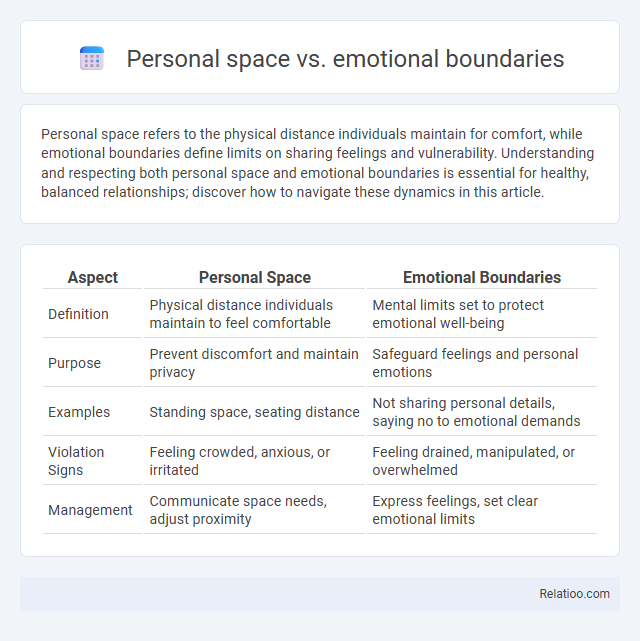Personal space refers to the physical distance individuals maintain for comfort, while emotional boundaries define limits on sharing feelings and vulnerability. Understanding and respecting both personal space and emotional boundaries is essential for healthy, balanced relationships; discover how to navigate these dynamics in this article.
Table of Comparison
| Aspect | Personal Space | Emotional Boundaries |
|---|---|---|
| Definition | Physical distance individuals maintain to feel comfortable | Mental limits set to protect emotional well-being |
| Purpose | Prevent discomfort and maintain privacy | Safeguard feelings and personal emotions |
| Examples | Standing space, seating distance | Not sharing personal details, saying no to emotional demands |
| Violation Signs | Feeling crowded, anxious, or irritated | Feeling drained, manipulated, or overwhelmed |
| Management | Communicate space needs, adjust proximity | Express feelings, set clear emotional limits |
Understanding Personal Space: The Physical Dimension
Understanding personal space involves recognizing the physical distance individuals maintain to feel comfortable and secure, which varies across cultures and situations. Emotional boundaries differ by focusing on protecting one's feelings and mental well-being, regulating how much emotional information is shared. Unlike emotional boundaries, personal space strictly emphasizes physical proximity, influencing nonverbal communication and social interactions.
Defining Emotional Boundaries: An Inner Framework
Emotional boundaries are defined as internal limits that protect an individual's emotional well-being by regulating how much emotional energy is shared or absorbed in relationships. Unlike physical personal space, which focuses on physical distance, emotional boundaries establish a framework to maintain psychological safety and prevent emotional overreach or manipulation. This inner framework helps individuals differentiate their feelings from others', enabling healthier interactions and self-care.
Key Differences Between Personal Space and Emotional Boundaries
Personal space refers to the physical distance individuals maintain to feel comfortable and secure, typically varying by culture and personal preference. Emotional boundaries involve protecting one's feelings and mental well-being by setting limits on emotional involvement and vulnerability. The key difference lies in personal space addressing tangible, physical proximity, while emotional boundaries govern intangible emotional limits and interpersonal dynamics.
The Role of Culture in Shaping Boundaries
Cultural norms significantly shape personal space, emotional boundaries, and interpersonal interactions, influencing how individuals perceive and maintain these limits. In collectivist societies, closer physical proximity and shared emotional experiences are common, while individualistic cultures often emphasize greater physical distance and distinct emotional boundaries to respect personal autonomy. Understanding these cultural differences is essential for effective communication and relationship-building across diverse social contexts.
Why Respecting Personal Space Matters
Respecting personal space is crucial for maintaining emotional boundaries and fostering healthy relationships. When you honor someone's physical and emotional limits, it promotes trust, reduces stress, and prevents misunderstandings. Your awareness of these boundaries supports mutual respect and emotional well-being in social interactions.
Emotional Boundaries in Relationships: Protecting Your Wellbeing
Emotional boundaries in relationships are crucial for protecting your mental and emotional wellbeing by clearly defining what feelings and experiences you are willing to share or protect. Unlike personal space, which refers to physical distance, emotional boundaries help maintain a healthy balance between intimacy and individuality, preventing manipulation and emotional exhaustion. Establishing firm emotional boundaries fosters trust, respect, and self-care, ensuring relationships remain supportive rather than draining.
Common Signs of Boundary Violations
Common signs of boundary violations include feeling discomfort, anxiety, or resentment when your personal space is invaded or your emotional boundaries are ignored. You might notice others dismissing your feelings, interrupting your thoughts, or pressuring you beyond your comfort level. Recognizing these signals helps maintain healthy interactions and protect both your personal space and emotional well-being.
How to Communicate Your Needs Assertively
Communicating your needs assertively involves clearly stating your personal space and emotional boundaries without apologizing or over-explaining, ensuring your comfort is respected in both physical and emotional interactions. Use "I" statements to express how certain actions affect you and set specific limits, such as "I need some time alone to recharge" or "I feel overwhelmed when personal topics are discussed too soon." Being consistent and calm when reinforcing these boundaries helps others understand and honor your needs effectively.
Balancing Closeness and Independence
Balancing closeness and independence requires understanding the difference between personal space, emotional boundaries, and physical proximity. Your personal space is the physical distance you prefer to maintain, while emotional boundaries protect your feelings and ensure respectful interaction. Recognizing these distinctions helps maintain healthy relationships by fostering intimacy without compromising your need for autonomy.
Practical Tips for Setting Healthy Boundaries
Setting healthy boundaries involves clearly defining personal space by communicating your physical limits and ensuring others respect your need for distance. Emotional boundaries require recognizing and asserting your feelings, protecting yourself from emotional overreach or manipulation. Practical tips include using assertive language, regularly assessing your comfort levels, and consistently reinforcing these limits to maintain respectful relationships.

Infographic: Personal space vs Emotional boundaries
 relatioo.com
relatioo.com